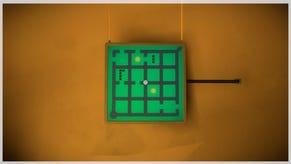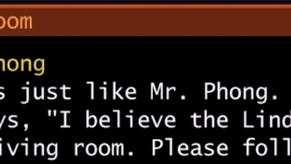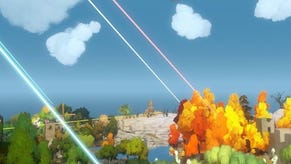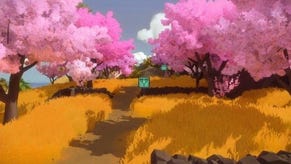Jonathan Blow
"In this game there are hardly any verbs…"
After Braid, Jonathan Blow's latest game, The Witness, seems like quite a departure: it's a 3D exploration experience set in a realistic environment rather than a dreamy watercoloured side-scroller. That said, it's still a dense congregation of ingenious puzzles, and it concerns itself, to a large extent, with a classic Braid preoccupation - the relationship between game themes and game mechanics. With the designer recently visiting London, we caught up with him to ask him a selection of rambling questions and received some surprisingly concise answers.
The point of them isn't just to be a puzzle. Every one of them has a little bit of communication in it. It always furthers progress of what you understand. Because that's non-verbal, each statement on its own has to be kind of simple, because if it's too complicated, people won't get it. Once it's kind of simple, it's automatically kind of fair, too.
A little bit. The necessity to introduce ideas like that does end up creating some of the content of the game, right? It's like, Okay, I have this idea for something that could be cool: I need to ramp up to it. That sort of creates the first half of a particular area, then.
Really, though, the bulk of the process is more about just exploring and finding these things. So I start out, and I have this idea that there's going to be a little panel and you can draw in it. Then I have the question: well, what can happen under that constraint? Well, you could have things in the path that you trace, or that you have to cover. You could have things that you have to divide, or you could have multiple things at once. It's really an exploration.
There are two stages. The first thing is finding individual things that at least sound interesting, and then trying them out. There's some things in the game that I tried out but which turned out to not be that good. So that's part one. Part two is seeing how these things then combine with each other. So you've got symmetry lines, say, and then the dots you have to cover, and then those things combine in an interesting way.
That is the general idea of the game, that the puzzles are reflected thematically within it. There are actually other levels to it that are sort of secret. So if you search through the environment carefully, you might find things that add another layer.

I think that's right. Part of it comes from the fact that I wanted this game to be about, well, it's about a lot of things. But I wanted it to be about what's in the puzzles and what's in the world, and I thought I could do that while keeping the controls as simple as possible.
Games these days have become about using all of the pad. For this game, I guess you need two sticks and maybe two buttons, which is still a lot, but it's less than a lot of other stuff. There aren't a lot of verbs that you have. So a thing that a lot of adventure games used to do, especially graphic adventure games, is they'd give you a lot of verbs, and then that would be part of the puzzle: which verb do I use on which object to make something happen.
But then a lot of the game is just cheap. Anyone can do that, I guess. Because in this game there are hardly any verbs, what is left is something about the purity of the situation, and of the puzzle. Because it's about that now, it's not surprising that you see similarities between this and Zelda and things like that. That's kind of the core reality of what happens when you put things in a game world thoughtfully rather than randomly.









